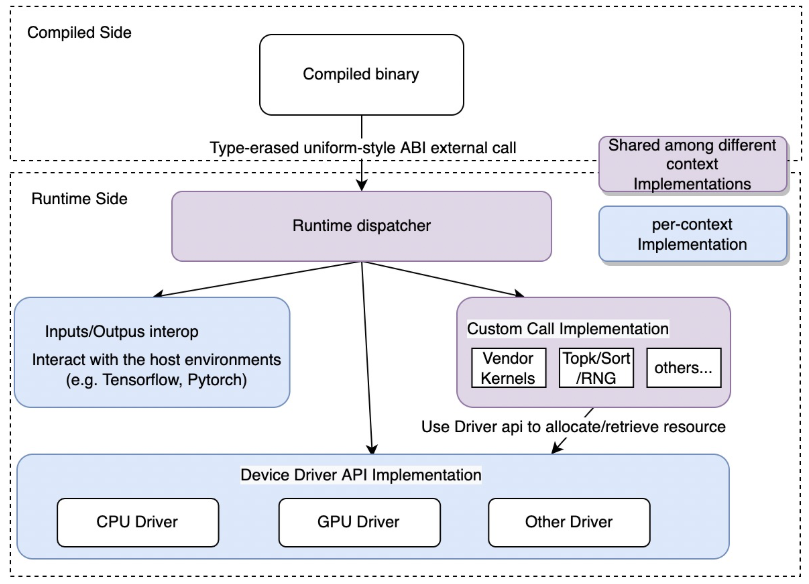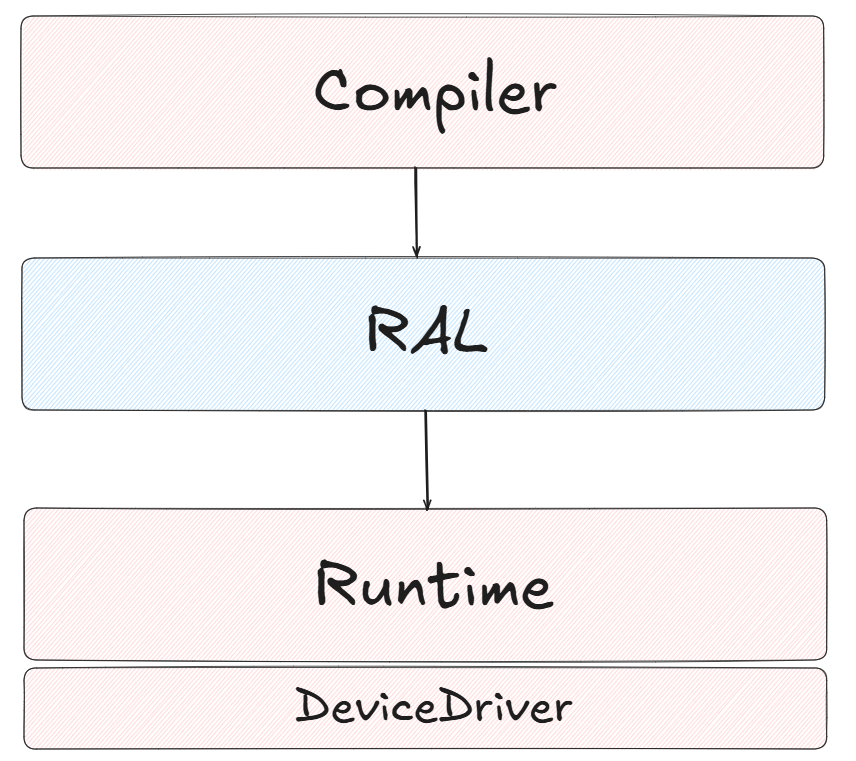1
2
3
4
5
6
7
8
9
10
11
12
13
14
15
16
17
18
19
20
21
22
23
24
25
26
27
28
29
30
31
32
33
34
35
36
37
38
39
40
41
42
43
44
45
46
47
48
49
50
51
52
53
54
55
56
57
58
59
60
61
62
63
64
65
66
67
68
69
70
71
72
73
74
75
76
77
78
79
80
81
82
83
84
85
86
87
88
89
90
91
92
93
94
95
96
97
98
|
func.func @main(%arg0: !disc_ral.context) attributes {tf.entry_function = {input_placements = "gpu", inputs = "input.1_", output_placements = "gpu", outputs = "8"}} {
%0 = llvm.mlir.constant(0 : i32) : i32
%false = arith.constant false
%true = arith.constant true
%c1 = arith.constant 1 : index
%c4 = arith.constant 4 : index
%c10 = arith.constant 10 : index
%c0 = arith.constant 0 : index
%1 = "disc_ral.dispatch"(%arg0, %c0) {backend_config = "", call_target_name = "ral_recv_input", device = "cpu", has_side_effect = false} : (!disc_ral.context, index) -> memref<?x10xf32, #gpu.address_space<global>>
%dim = memref.dim %1, %c0 : memref<?x10xf32, #gpu.address_space<global>>
%alloc = memref.alloc() : memref<10x10xf32, #gpu.address_space<global>>
"lmhlo.constant"(%alloc) {disc.device = "gpu", value = dense_resource<__elided__> : tensor<10x10xf32>} : (memref<10x10xf32, #gpu.address_space<global>>) -> ()
%alloc_0 = memref.alloc() : memref<10x10xf32, #gpu.address_space<global>>
"lmhlo.constant"(%alloc_0) {disc.device = "gpu", value = dense_resource<__elided__> : tensor<10x10xf32>} : (memref<10x10xf32, #gpu.address_space<global>>) -> ()
%alloc_1 = memref.alloc() : memref<10xf32, #gpu.address_space<global>>
"lmhlo.constant"(%alloc_1) {disc.device = "gpu", value = dense<[0.186997086, 0.235856801, 0.217500299, 0.25940907, 0.109970599, -0.152944937, 0.137896746, -0.189537019, 0.256005555, 0.235299528]> : tensor<10xf32>} : (memref<10xf32, #gpu.address_space<global>>) -> ()
%alloc_2 = memref.alloc() : memref<10xf32, #gpu.address_space<global>>
"lmhlo.constant"(%alloc_2) {disc.device = "gpu", value = dense<[0.281509697, -0.0671350583, -0.291665494, 0.300998032, -0.304899603, 0.23629041, -0.111676671, 0.304613203, 0.107744612, -0.118951075]> : tensor<10xf32>} : (memref<10xf32, #gpu.address_space<global>>) -> ()
%reinterpret_cast = memref.reinterpret_cast %1 to offset: [0], sizes: [%dim, 10], strides: [10, 1] {kDiscSymbolicDimAttr = [@S0, @C10]} : memref<?x10xf32, #gpu.address_space<global>> to memref<?x10xf32, #gpu.address_space<global>>
%alloc_3 = memref.alloc(%dim) {kDiscSymbolicDimAttr = [@S0, @C10]} : memref<?x10xf32, #gpu.address_space<global>>
%2 = llvm.inttoptr %0 : i32 to !llvm.ptr<i8>
"disc_ral.dispatch"(%arg0, %2, %reinterpret_cast, %alloc_0, %alloc_3, %false, %false, %true) {backend_config = "", call_target_name = "ral_gemm", device = "gpu", has_side_effect = false} : (!disc_ral.context, !llvm.ptr<i8>, memref<?x10xf32, #gpu.address_space<global>>, memref<10x10xf32, #gpu.address_space<global>>, memref<?x10xf32, #gpu.address_space<global>>, i1, i1, i1) -> ()
memref.dealloc %alloc_0 : memref<10x10xf32, #gpu.address_space<global>>
%alloca = memref.alloca() {alignment = 64 : i64} : memref<2xindex>
memref.store %dim, %alloca[%c0] : memref<2xindex>
memref.store %c10, %alloca[%c1] : memref<2xindex>
%3 = arith.muli %dim, %c10 : index
%4 = arith.remui %3, %c4 : index
%5 = arith.cmpi eq, %4, %c0 : index
%alloc_4 = memref.alloc() : memref<f32, #gpu.address_space<global>>
%alloc_5 = memref.alloc(%dim) {kDiscSymbolicDimAttr = [@S0, @C10]} : memref<?x10xf32, #gpu.address_space<global>>
%alloc_6 = memref.alloc(%dim) {kDiscSymbolicDimAttr = [@S0, @C10]} : memref<?x10xf32, #gpu.address_space<global>>
%alloc_7 = memref.alloc(%dim) {kDiscSymbolicDimAttr = [@S0, @C10]} : memref<?x10xf32, #gpu.address_space<global>>
%alloc_8 = memref.alloc(%dim) {kDiscSymbolicDimAttr = [@S0, @C10]} : memref<?x10xf32, #gpu.address_space<global>>
scf.if %5 {
"lmhlo.fusion"() ({
"lmhlo.constant"(%alloc_4) {disc.device = "gpu", value = dense<0.000000e+00> : tensor<f32>} : (memref<f32, #gpu.address_space<global>>) -> ()
"lmhlo.dynamic_broadcast_in_dim"(%alloc_1, %alloca, %alloc_5) {broadcast_dimensions = dense<1> : tensor<1xi64>, disc.device = "gpu"} : (memref<10xf32, #gpu.address_space<global>>, memref<2xindex>, memref<?x10xf32, #gpu.address_space<global>>) -> ()
"lmhlo.add"(%alloc_3, %alloc_5, %alloc_6) {disc.device = "gpu"} : (memref<?x10xf32, #gpu.address_space<global>>, memref<?x10xf32, #gpu.address_space<global>>, memref<?x10xf32, #gpu.address_space<global>>) -> ()
"lmhlo.dynamic_broadcast_in_dim"(%alloc_4, %alloca, %alloc_8) {broadcast_dimensions = dense<> : tensor<0xi64>, disc.device = "gpu"} : (memref<f32, #gpu.address_space<global>>, memref<2xindex>, memref<?x10xf32, #gpu.address_space<global>>) -> ()
"lmhlo.maximum"(%alloc_6, %alloc_8, %alloc_7) {disc.device = "gpu"} : (memref<?x10xf32, #gpu.address_space<global>>, memref<?x10xf32, #gpu.address_space<global>>, memref<?x10xf32, #gpu.address_space<global>>) -> ()
"lmhlo.terminator"() : () -> ()
}) {disc.device = "gpu", disc.fusion.name = "main_kLoop_maximum__5_1_0", disc.fusion.tag = "Vec4", disc.fusion_type = "kLoop", disc_vectorize_or_tile_hint = 4 : i32} : () -> ()
} else {
"lmhlo.fusion"() ({
"lmhlo.constant"(%alloc_4) {disc.device = "gpu", value = dense<0.000000e+00> : tensor<f32>} : (memref<f32, #gpu.address_space<global>>) -> ()
"lmhlo.dynamic_broadcast_in_dim"(%alloc_1, %alloca, %alloc_5) {broadcast_dimensions = dense<1> : tensor<1xi64>, disc.device = "gpu"} : (memref<10xf32, #gpu.address_space<global>>, memref<2xindex>, memref<?x10xf32, #gpu.address_space<global>>) -> ()
"lmhlo.add"(%alloc_3, %alloc_5, %alloc_6) {disc.device = "gpu"} : (memref<?x10xf32, #gpu.address_space<global>>, memref<?x10xf32, #gpu.address_space<global>>, memref<?x10xf32, #gpu.address_space<global>>) -> ()
"lmhlo.dynamic_broadcast_in_dim"(%alloc_4, %alloca, %alloc_8) {broadcast_dimensions = dense<> : tensor<0xi64>, disc.device = "gpu"} : (memref<f32, #gpu.address_space<global>>, memref<2xindex>, memref<?x10xf32, #gpu.address_space<global>>) -> ()
"lmhlo.maximum"(%alloc_6, %alloc_8, %alloc_7) {disc.device = "gpu"} : (memref<?x10xf32, #gpu.address_space<global>>, memref<?x10xf32, #gpu.address_space<global>>, memref<?x10xf32, #gpu.address_space<global>>) -> ()
"lmhlo.terminator"() : () -> ()
}) {disc.device = "gpu", disc.fusion.name = "main_kLoop_maximum__5_1_0", disc.fusion_type = "kLoop", disc_vectorize_or_tile_hint = 1 : i32} : () -> ()
}
memref.dealloc %alloc_8 : memref<?x10xf32, #gpu.address_space<global>>
memref.dealloc %alloc_6 : memref<?x10xf32, #gpu.address_space<global>>
memref.dealloc %alloc_5 : memref<?x10xf32, #gpu.address_space<global>>
memref.dealloc %alloc_4 : memref<f32, #gpu.address_space<global>>
memref.dealloc %alloc_3 : memref<?x10xf32, #gpu.address_space<global>>
memref.dealloc %alloc_1 : memref<10xf32, #gpu.address_space<global>>
%alloc_9 = memref.alloc(%dim) {kDiscSymbolicDimAttr = [@S0, @C10]} : memref<?x10xf32, #gpu.address_space<global>>
%6 = llvm.inttoptr %0 : i32 to !llvm.ptr<i8>
"disc_ral.dispatch"(%arg0, %6, %alloc_7, %alloc, %alloc_9, %false, %false, %true) {backend_config = "", call_target_name = "ral_gemm", device = "gpu", has_side_effect = false} : (!disc_ral.context, !llvm.ptr<i8>, memref<?x10xf32, #gpu.address_space<global>>, memref<10x10xf32, #gpu.address_space<global>>, memref<?x10xf32, #gpu.address_space<global>>, i1, i1, i1) -> ()
memref.dealloc %alloc_7 : memref<?x10xf32, #gpu.address_space<global>>
memref.dealloc %alloc : memref<10x10xf32, #gpu.address_space<global>>
%alloc_10 = memref.alloc() : memref<f32, #gpu.address_space<global>>
%alloc_11 = memref.alloc(%dim) {kDiscSymbolicDimAttr = [@S0, @C10]} : memref<?x10xf32, #gpu.address_space<global>>
%alloc_12 = memref.alloc(%dim) {kDiscSymbolicDimAttr = [@S0, @C10]} : memref<?x10xf32, #gpu.address_space<global>>
%alloc_13 = memref.alloc(%dim) {kDiscSymbolicDimAttr = [@S0, @C10]} : memref<?x10xf32, #gpu.address_space<global>>
%alloc_14 = memref.alloc(%dim) {kDiscSymbolicDimAttr = [@S0, @C10]} : memref<?x10xf32, #gpu.address_space<global>>
scf.if %5 {
"lmhlo.fusion"() ({
"lmhlo.constant"(%alloc_10) {value = dense<0.000000e+00> : tensor<f32>} : (memref<f32, #gpu.address_space<global>>) -> ()
"lmhlo.dynamic_broadcast_in_dim"(%alloc_10, %alloca, %alloc_11) {broadcast_dimensions = dense<> : tensor<0xi64>, disc.device = "gpu"} : (memref<f32, #gpu.address_space<global>>, memref<2xindex>, memref<?x10xf32, #gpu.address_space<global>>) -> ()
"lmhlo.dynamic_broadcast_in_dim"(%alloc_2, %alloca, %alloc_12) {broadcast_dimensions = dense<1> : tensor<1xi64>, disc.device = "gpu"} : (memref<10xf32, #gpu.address_space<global>>, memref<2xindex>, memref<?x10xf32, #gpu.address_space<global>>) -> ()
"lmhlo.add"(%alloc_9, %alloc_12, %alloc_13) {disc.device = "gpu"} : (memref<?x10xf32, #gpu.address_space<global>>, memref<?x10xf32, #gpu.address_space<global>>, memref<?x10xf32, #gpu.address_space<global>>) -> ()
"lmhlo.maximum"(%alloc_13, %alloc_11, %alloc_14) {disc.device = "gpu"} : (memref<?x10xf32, #gpu.address_space<global>>, memref<?x10xf32, #gpu.address_space<global>>, memref<?x10xf32, #gpu.address_space<global>>) -> ()
"lmhlo.terminator"() : () -> ()
}) {disc.device = "gpu", disc.fusion.name = "main_kLoop_maximum__5_1_1", disc.fusion.tag = "Vec4", disc.fusion_type = "kLoop", disc_vectorize_or_tile_hint = 4 : i32} : () -> ()
} else {
"lmhlo.fusion"() ({
"lmhlo.constant"(%alloc_10) {value = dense<0.000000e+00> : tensor<f32>} : (memref<f32, #gpu.address_space<global>>) -> ()
"lmhlo.dynamic_broadcast_in_dim"(%alloc_10, %alloca, %alloc_11) {broadcast_dimensions = dense<> : tensor<0xi64>, disc.device = "gpu"} : (memref<f32, #gpu.address_space<global>>, memref<2xindex>, memref<?x10xf32, #gpu.address_space<global>>) -> ()
"lmhlo.dynamic_broadcast_in_dim"(%alloc_2, %alloca, %alloc_12) {broadcast_dimensions = dense<1> : tensor<1xi64>, disc.device = "gpu"} : (memref<10xf32, #gpu.address_space<global>>, memref<2xindex>, memref<?x10xf32, #gpu.address_space<global>>) -> ()
"lmhlo.add"(%alloc_9, %alloc_12, %alloc_13) {disc.device = "gpu"} : (memref<?x10xf32, #gpu.address_space<global>>, memref<?x10xf32, #gpu.address_space<global>>, memref<?x10xf32, #gpu.address_space<global>>) -> ()
"lmhlo.maximum"(%alloc_13, %alloc_11, %alloc_14) {disc.device = "gpu"} : (memref<?x10xf32, #gpu.address_space<global>>, memref<?x10xf32, #gpu.address_space<global>>, memref<?x10xf32, #gpu.address_space<global>>) -> ()
"lmhlo.terminator"() : () -> ()
}) {disc.device = "gpu", disc.fusion.name = "main_kLoop_maximum__5_1_1", disc.fusion_type = "kLoop", disc_vectorize_or_tile_hint = 1 : i32} : () -> ()
}
memref.dealloc %alloc_13 : memref<?x10xf32, #gpu.address_space<global>>
memref.dealloc %alloc_12 : memref<?x10xf32, #gpu.address_space<global>>
memref.dealloc %alloc_11 : memref<?x10xf32, #gpu.address_space<global>>
memref.dealloc %alloc_10 : memref<f32, #gpu.address_space<global>>
memref.dealloc %alloc_9 : memref<?x10xf32, #gpu.address_space<global>>
memref.dealloc %alloc_2 : memref<10xf32, #gpu.address_space<global>>
"disc_ral.dispatch"(%arg0, %c0, %alloc_14) {backend_config = "", call_target_name = "ral_send_output", device = "cpu", has_side_effect = false} : (!disc_ral.context, index, memref<?x10xf32, #gpu.address_space<global>>) -> ()
return
}
|


